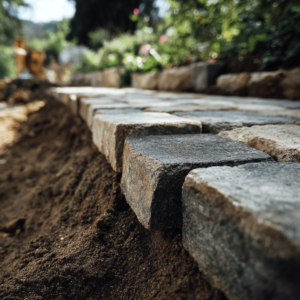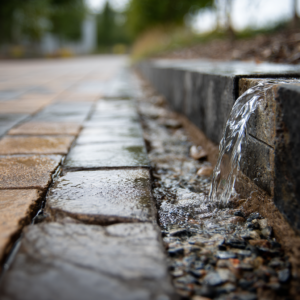Sealing a concrete installation, both poured on in the form of pavers, is one of the most important aspects of it. It’s the final step of the process and what ensures your installation will be protected for years to come. But how long does it take for concrete sealer to dry?
That’s a crucial question. Apply pressure too soon, and you can compromise the integrity of the sealer. Wait too long, and you’re wasting valuable time. So let’s talk about the timeframe it takes for a sealer to dry, as well as the importance of sealing as a whole.
Jump to:
How Long Do Sealers Take to Dry?
That question can be more challenging than it seems at first. Mainly because there are many types of sealers you can use on your concrete installation.
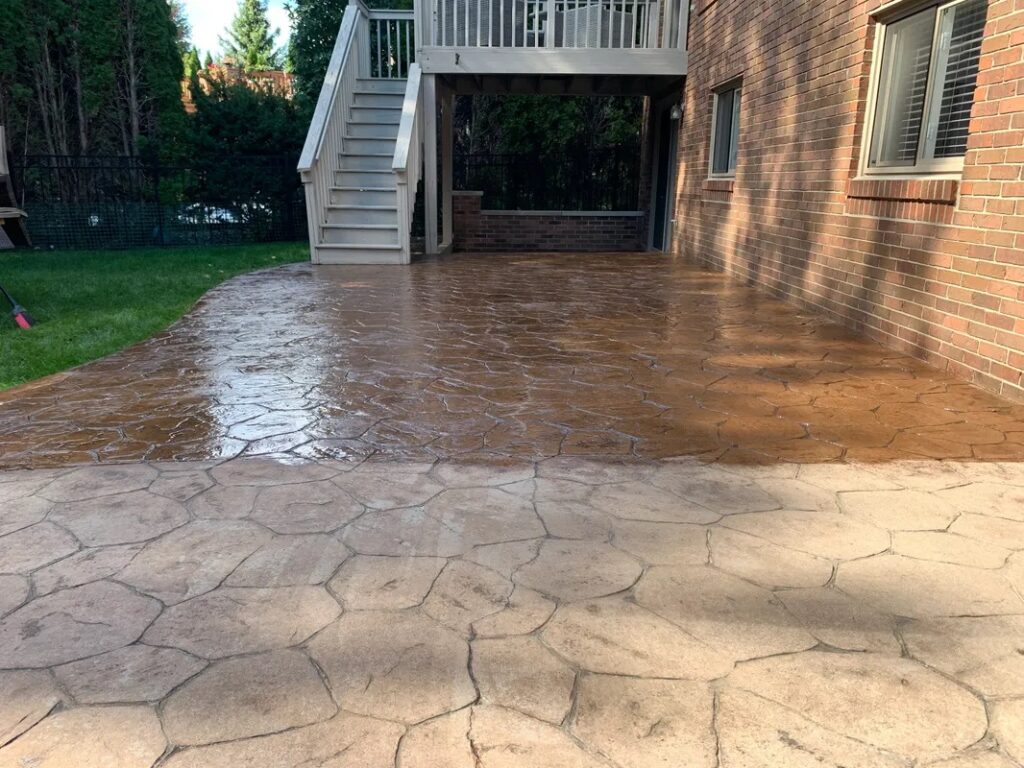
First, we have to make a quick, albeit important, distinction here. Drying is different from finishing reaction (curing).
What does that mean? Well, by drying, we mean that the sealer will be, basically, safe to be walked upon. Most sealers can quickly dry between 1 and 3 hours, but take as long as 90 days to finish fully reacting to the concrete, for example.
So let’s talk about the different kinds of sealers and their respective drying times.
Acrylic Concrete Sealers
- Walkable after 12 hours
- Dry to touch in 4–8 hours
- Fully cured in 48 hours
Maybe the most popular sealer available, responsible for that “wet look” that many homeowners look for, as well as the low and high gloss finishes.
These sealers usually take around 48 hours to be completely dry, so any activity before that is forbidden. Avoid traffic, water exposure, or heavy objects for at least two full days after application. If absolutely necessary, they can be walked on after 12 hours.
Silane and Siliconate Sealers
- Safe to walk on after 30–60 minutes
- Fully functional after 24–72 hours
These categories of sealers are designed to prevent the absorption of water. They reduce the damage that can be caused by freeze-thaw cycles, making them an excellent choice for regions of extreme weather.
Furthermore, they also prevent the formation of mold, mildew, and efflorescence. Unlike the acrylic sealers, they won’t change the appearance of the pavers and work completely below the surface.
For that reason, they appear to dry and can be safely walked upon as soon as 30 minutes after the application, but they take up to 72 hours to become fully functional, so avoid activity during that timeframe.
Silicate Concrete Sealers
- Dry to the touch within 1 hour
- Full cure in 7–90 days
These are simply made to make maintenance easier. They prevent the formation of dust and improve the strength of the installation as a whole.
They are a good idea to keep balconies and outdoor living spaces tidy and free of dust. And, with improved strength, they are less prone to be damaged by a power wash, one of the most effective cleaning methods of concrete there is.
They also dry very quickly, up to 1 hour tops, but take a long time to fully react with the concrete. You might have to wait up to 90 days for it to be completely dry.
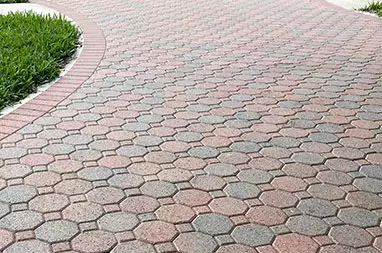
Urethane Coating Sealers
- Touch dry in 6–12 hours
- Foot traffic is safe after 24 hours
- Full cure in 36–48 hours
Urethane coatings are your sealers of choice for interior concrete installations. They are designed to protect the concrete against oil and chemicals.
Here we have a great variance of drying times – really dependent on the brand you end up choosing. The best is to always follow the label instructions.
Still, most options will have a time frame of 36 to 48 hours to dry, so it is not a good idea to wait at least two days for it to be completely dry.
Epoxy Coating Sealers
- Walkable after 12 hours
- Dry to touch in 6–8 hours
- Full cure after 48–72 hours
Epoxy is an overall enhancer and protector for interior concrete installations. It changes a bit the color of the concrete, making it a little brighter while also improving its resistance.
They can be walked on after about 12 hours, but get completely dry only after a 48-hour period.
How Long Does it Take for a Concrete Sealer to Dry? Factors that Influence Drying Times
Even with all these guidelines, environmental conditions can alter drying time significantly.
Temperature
Warm temperatures speed up drying, but applying sealer in direct sunlight or over 90°F can cause it to bubble or flash cure. The ideal range? 50 °F to 85 °F.
Humidity
High humidity slows evaporation. If rain is in the forecast within 24 hours, postpone your sealing job. Concrete should be completely dry before sealer is applied to avoid trapping moisture.
Surface Porosity
Older or more porous concrete will absorb sealer faster. If sealing pavers, be sure to clean and dry them thoroughly first.
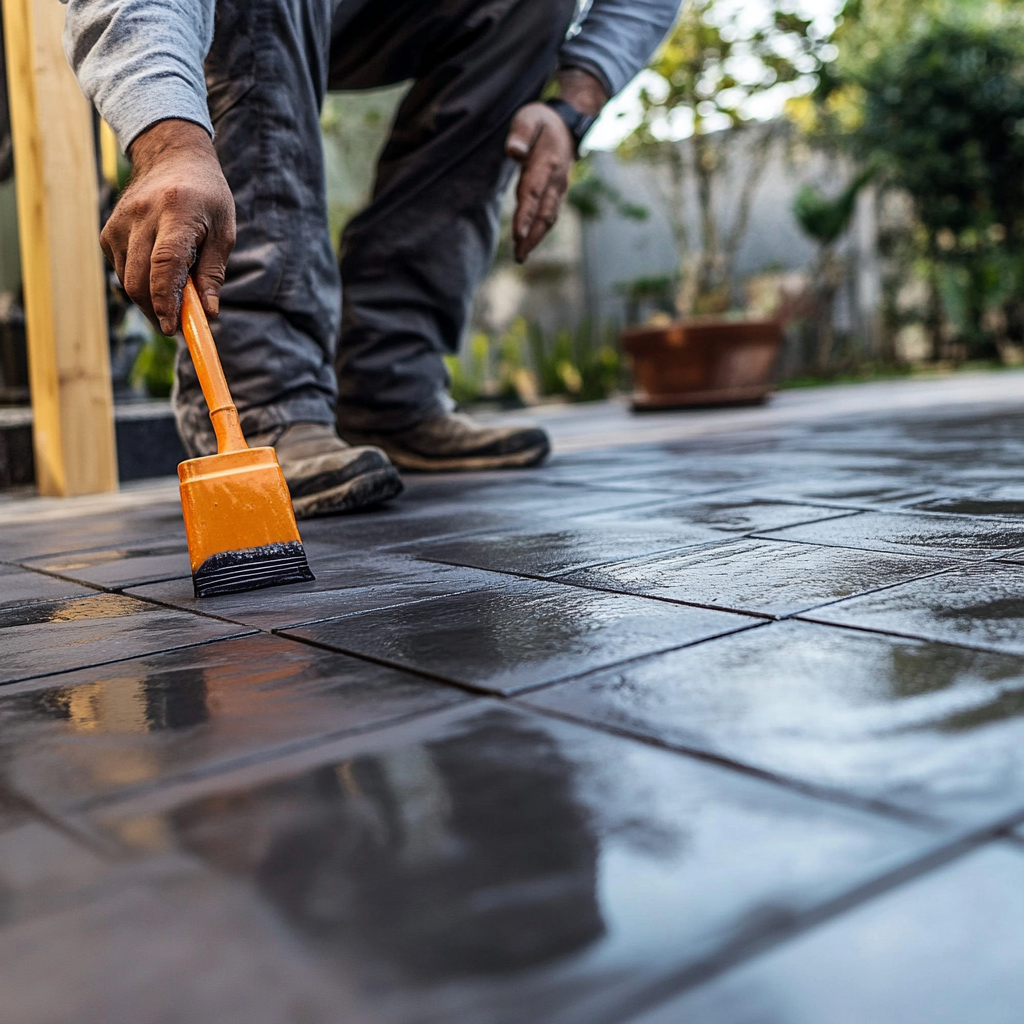
The Importance of Sealing
Sealing is the final but arguably the most crucial step in any concrete or paver installation.
While concrete is known for its strength, it is also highly porous, meaning it naturally absorbs water, oil, chemicals, and debris. Left unsealed, these substances can penetrate the surface and cause discoloration, stains, and long-term structural damage.
Sealing creates a protective barrier that shields the surface from the elements. For exterior applications, this means preventing moisture from seeping in, which is especially important in areas exposed to freeze-thaw cycles.
Water that gets absorbed into unsealed concrete can expand when frozen, causing surface cracks and internal fractures over time.
In high-traffic areas like driveways or pool decks, sealers help prevent wear and tear from vehicle tires, foot traffic, pool chemicals, and UV exposure. Without a sealer, concrete surfaces can quickly fade and become brittle due to sun damage.
For pavers, sealing does more than protect—it enhances. A good sealer brings out the natural color of the stone or concrete, giving it a richer, cleaner appearance. It also helps lock in joint sand, keeping weeds, ants, and shifting at bay.
Indoor surfaces also benefit from sealing. In garages or basements, sealers protect against oil spills, humidity, and mildew, making the space cleaner and easier to maintain.
The long-term benefits are undeniable: reduced maintenance, a better-looking surface, and increased durability. While sealing requires some upfront investment, it can extend the life of your surface by decades.
If you’re investing in a new installation – or maintaining an old one – sealing isn’t optional. It’s a key step that pays for itself in longevity, performance, and curb appeal.
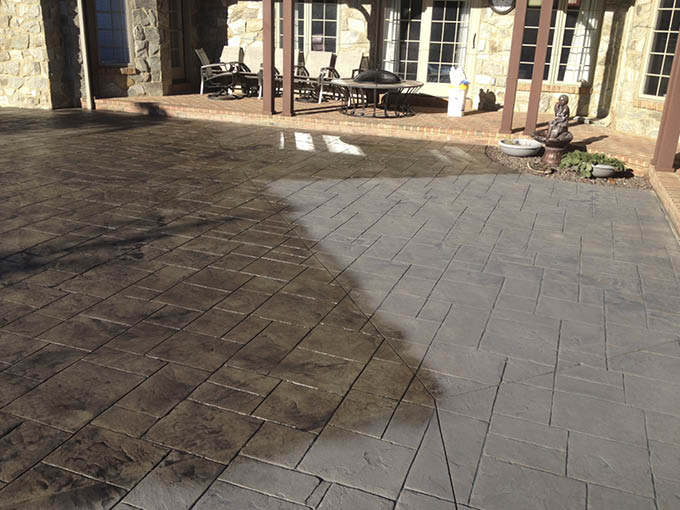
Common Mistakes to Avoid When Sealing Concrete
Applying concrete sealer might seem straightforward, but several common mistakes can lead to poor results or even damage the surface. Here’s what to avoid to get the most from your sealing project.
Sealing Wet Concrete
One of the biggest mistakes is applying sealer before the concrete is fully dry. Moisture trapped beneath the sealer can cause bubbling, hazing, or even mold growth. Always wait at least 24 to 48 hours after cleaning or rain, and use a moisture meter if you’re unsure.
Applying Too Much Sealer
More isn’t better. Applying thick or multiple coats in quick succession can lead to a cloudy appearance or a sticky surface. Follow the manufacturer’s instructions, and apply in thin, even layers.
Skipping Surface Prep
Sealing over dirty or stained concrete locks those imperfections. Always start with a thorough cleaning, including degreasing and removing any old sealer residue. Use a pressure washer or concrete cleaner for best results.
Wrong Product for the Job
There’s no one-size-fits-all sealer. Epoxies are great for indoor floors, but not for patios. Silanes are perfect for damp climates, but don’t enhance color. Choosing the wrong type can lead to reduced effectiveness or visual disappointment.
Ignoring Weather Conditions
Temperature and humidity matter. Applying sealer in direct sun or during very hot weather can cause it to flash cure, leading to streaks or bubbles. Ideal conditions are mild temperatures and low humidity.

Professional Help With Sealing
If you happen to be around the area, give us a call anytime at +1 941 586 9140 or email us at [email protected]. We would be happy to help with paver installations or maintenance needs you might have.

